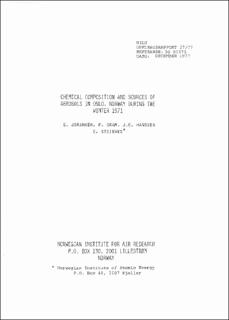| dc.description.abstract | This work is part of an extensive study during the winter season 1970-71 of air pollution by SO2 and black smoke in Oslo, Norway in relation to meteorological conditions. The study was based on samples of atmospheric particulates from 25 stations in the area from 6 selected days during the period 4 February - 8 March 1971. Neutron activation analysis was used for the determination of the trace elements Al, Ti, Mn, Br, Cr, Fe, Zn, Sb, and flameless atomic absorption spectrometry for Cd and Pb.
The investigation shows that the concentrations of some metallic elements could be very high during inversions in the winter season, mainly in the industrial area in the northern part of Oslo and in the lower central parts of Oslo. Some concentration values for elements such as iron, manganese and zinc are among the highest reported for urban areas in the U.S.A.
The concentrations of black smoke show high correlation with lead and bromine. This indicates that automobile traffic is a major source of black smoke in the area.
The SO2 concentrations show the highest correlation with vanadium, bromine and lead, which indicate that besides the burning of fuel oil, automobile traffic also may be a signi- ficant source of the SO2 pollution near the surface. | |
